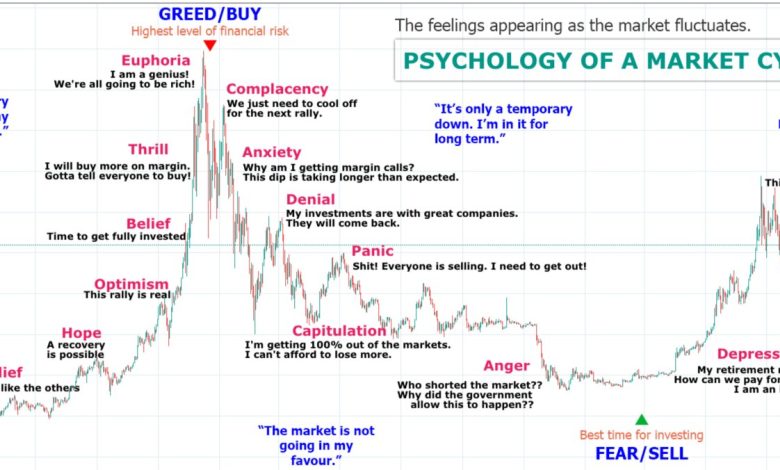Understanding Market Psychology in Crypto Trading Today

- The Role of Emotions in Crypto Trading
- Analyzing the Impact of Fear and Greed on Market Trends
- Strategies for Managing Psychological Biases in Trading
- The Influence of Social Media on Investor Sentiment
- Psychological Factors Behind Price Volatility in Cryptocurrency
- Case Studies on Market Psychology in Crypto Trading
The Role of Emotions in Crypto Trading
Emotions play a crucial role in the world of crypto trading. The market is highly volatile, and traders often make decisions based on fear, greed, excitement, or panic. These emotions can lead to impulsive actions that may not be based on rational analysis.
It is essential for traders to understand how emotions can impact their trading decisions. Fear of missing out (FOMO) can lead to buying assets at inflated prices, while fear of losing out (FOLO) can result in selling assets prematurely. Greed can cause traders to hold onto assets for too long, hoping for even higher profits.
On the other hand, excitement can cloud judgment and lead to taking unnecessary risks. Panic selling during a market downturn can result in significant losses. By recognizing and managing these emotions, traders can make more informed decisions and avoid falling into common psychological traps.
Analyzing the Impact of Fear and Greed on Market Trends
Understanding market psychology in crypto trading today involves analyzing the impact of fear and greed on market trends. These two emotions play a significant role in driving the behavior of traders and investors in the cryptocurrency market.
Fear can cause traders to panic sell their assets, leading to a sharp decline in prices. On the other hand, greed can drive traders to FOMO (fear of missing out) and buy assets at inflated prices. Both fear and greed can create volatility in the market, making it challenging to predict price movements accurately.
It is essential for traders to be aware of the influence of fear and greed on market trends and to manage their emotions effectively. By understanding how these emotions impact market behavior, traders can make more informed decisions and avoid falling victim to irrational trading practices.
Strategies for Managing Psychological Biases in Trading
When it comes to trading in the volatile world of cryptocurrency, it is essential to be aware of the psychological biases that can impact your decision-making process. Here are some strategies to help you manage these biases effectively:
- Diversification: One way to mitigate the impact of psychological biases is to diversify your investment portfolio. By spreading your investments across different assets, you can reduce the risk of being overly influenced by any single bias.
- Setting Clear Goals: Establishing clear trading goals can help you stay focused on your long-term objectives and avoid making impulsive decisions based on emotions.
- Utilizing Stop-Loss Orders: Implementing stop-loss orders can help you limit your losses and prevent you from holding onto a losing position for too long due to the fear of missing out.
- Staying Informed: Keeping yourself informed about market trends and developments can help you make more informed decisions based on facts rather than emotions.
- Seeking Professional Advice: If you find it challenging to manage your psychological biases on your own, consider seeking advice from a professional financial advisor who can provide you with an objective perspective.
By incorporating these strategies into your trading routine, you can better navigate the complexities of market psychology in crypto trading and improve your overall trading performance.
The Influence of Social Media on Investor Sentiment
One of the key factors influencing investor sentiment in today’s crypto trading market is the pervasive influence of social media platforms. Social media has become a powerful tool for shaping opinions, spreading information, and influencing decision-making processes. Platforms like Twitter, Reddit, and Telegram are popular channels where traders and investors gather to discuss market trends, share insights, and express their views on various cryptocurrencies.
Through social media, investors are exposed to a wide range of opinions, news, and rumors that can significantly impact their sentiment towards a particular cryptocurrency. Positive or negative sentiment expressed by influential figures or popular accounts on social media can create a ripple effect, causing a surge or decline in the value of a digital asset. This phenomenon highlights the interconnected nature of social media and investor sentiment in the crypto market.
Moreover, social media platforms have also become breeding grounds for market manipulation, pump-and-dump schemes, and misinformation campaigns. Traders need to exercise caution and critical thinking when consuming information from social media sources to avoid falling victim to false narratives or fraudulent activities. Understanding the dynamics of social media influence on investor sentiment is crucial for making informed trading decisions in the volatile world of cryptocurrency.
Psychological Factors Behind Price Volatility in Cryptocurrency
One of the key factors contributing to the volatility of prices in the cryptocurrency market is the psychological aspect of traders and investors. Understanding the psychological factors behind price fluctuations can help traders make more informed decisions and navigate the market more effectively.
One psychological factor that influences price volatility in cryptocurrency is market sentiment. Market sentiment refers to the overall feeling or attitude of traders and investors towards a particular asset. Positive sentiment can drive prices up, while negative sentiment can lead to price drops. Traders need to be aware of shifts in market sentiment and how they can impact price movements.
Another psychological factor that plays a role in price volatility is fear and greed. Fear of missing out (FOMO) can drive prices up as traders rush to buy in, while fear of loss can lead to panic selling and price drops. On the other hand, greed can cause traders to hold onto assets longer than they should, leading to price bubbles and eventual crashes.
Moreover, cognitive biases such as confirmation bias and herd mentality can also contribute to price volatility in cryptocurrency. Confirmation bias is the tendency to seek out information that confirms one’s existing beliefs, leading traders to ignore contradictory data. Herd mentality, on the other hand, is the tendency to follow the actions of the majority, even if it may not be the most rational decision.
Overall, understanding the psychological factors behind price volatility in cryptocurrency is essential for traders looking to navigate the market successfully. By being aware of market sentiment, fear and greed, as well as cognitive biases, traders can make more informed decisions and better manage their risk exposure in the volatile world of crypto trading.
Case Studies on Market Psychology in Crypto Trading
Case studies on market psychology in crypto trading provide valuable insights into the behavior of traders and investors in the volatile cryptocurrency market. By analyzing real-life examples, we can gain a better understanding of how emotions such as fear, greed, and FOMO (fear of missing out) can impact trading decisions.
One such case study involves the phenomenon of “panic selling” during a market downturn. When prices start to drop rapidly, many traders give in to fear and sell their assets at a loss, fearing that the market will continue to decline. This behavior often exacerbates the situation, leading to further price drops.
On the other hand, there are also instances of “irrational exuberance” in the crypto market, where investors become overly optimistic about a particular asset and drive up its price to unsustainable levels. This can create a bubble that eventually bursts, causing significant losses for those who bought in at the peak.
By studying these cases, traders can learn to recognize the signs of market psychology at play and make more informed decisions. It is essential to remain calm and rational in the face of market fluctuations, rather than letting emotions dictate trading strategies. Developing a solid understanding of market psychology can help traders navigate the unpredictable world of crypto trading more effectively.



